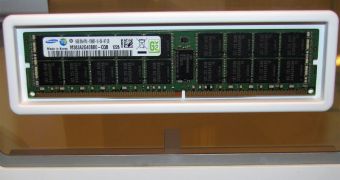Even though it won't be releasing DDR4 memory as soon as it and mostly everyone else hoped, Samsung is eager to prove that it has already passed beyond the first R&D stages.
Today (September 13) is the last day of the Intel Developer Forum, so there are still some things waiting to come to light.
Intel has already released most, if not all, the new information it planned to disclose, like some essentials about the Haswell CPU architecture, ultrabook design plans, expectations from Atom Clover Trail, etc.
Meanwhile, the collaborators that attended Intel's trade show have been launching and/or detailing their own plans and accomplishments.
Seagate got special mention for its SSHDs (solid state hybrid drives). Now, Samsung is in the limelight, but for a different reason.
The company has reportedly demonstrated next-generation DDR4 chips and memory modules, including a 16 GB PC4-17000 284-pin DDR4 module, with a clock speed of 2,133 MHz.
And here some will say that DDR3 can already reach 2,133 MHz, and more. And that is true. However, only overclockers manage that, and a few ultra-high-end modules. The “default' settings are of 1,333 MHz and 1,600 MHz.
2,133 MHz is actually slow for DDR4 dynamic random access memory. 2,400 MHz and 2,666 MHz should be easy to attain, and even then there will be a lot of room for overclockers to go higher, until gaming and server modules can work at 3.2 GHz.
Unfortunately, we won't be seeing any of this in the near future, despite the fact that the DDR4 specification was supposed to be completed last year (2011) and enter mass production in 2012.
At this point, the specification will only be done in the fourth quarter of this year, so mass availability will only be attained in 2014.
For those that want to know more technical details, DDR4 will have a voltage of 1.2V, per-pin data rates of 1.6 GT/s (giga transfers per second) and through-silicon-via (TSV) technology (will allow chip capacity to rise quickly).

 14 DAY TRIAL //
14 DAY TRIAL //